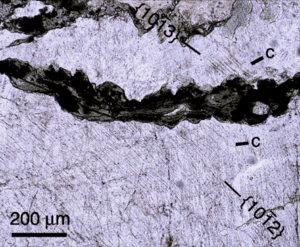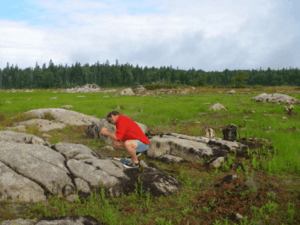Bloody Creek crater facts for kids
| Impact crater/structure | |
|---|---|
| Confidence | Probable |
| Diameter | 420 m × 350 m (1,380 ft × 1,150 ft) |
| Age | Neogene or younger in age |
| Exposed | Submerged beneath Dalhousie Lake |
| Drilled | No |
| Location | |
| Coordinates | 44°45′00″N 65°14′30″W / 44.75000°N 65.24167°W |
| Country | Canada |
| Province | Nova Scotia |
The Bloody Creek crater, also called the Bloody Creek structure, is a large, oval-shaped area in southwestern Nova Scotia, Canada. It measures about 420 meters (1,378 feet) by 350 meters (1,148 feet) across. Scientists believe it might be an impact crater, formed when something from space, like a meteor, crashed into Earth. This interesting spot is located between Bridgetown and West Dalhousie in Annapolis County, Nova Scotia. It even has a nickname: the Astrid crater.
Contents
How Was the Bloody Creek Crater Found?
The Bloody Creek structure was discovered in 1987 by Dr. George R. Stevens. He was a retired geologist from Acadia University. He found it while looking at aerial photos of the region.
By the time it was found, the area was already underwater. It was covered by a reservoir called Dalhousie Lake. This lake was made when a dam was built across Bloody Creek. The dam was part of a project to create hydroelectric power.
Because the crater is underwater, studying it is tricky! Scientists have to use scuba gear to collect rock samples. They also visit the site when the lake is sometimes drained. When Dalhousie Lake freezes in winter, the thick ice helps. It creates a platform for using special tools like magnetometers and ground-penetrating radar to map the area. Before it was flooded, the crater's center was a wet, grassy area within the Bloody Creek floodplain.
What Does the Crater Look Like?
The Bloody Creek structure is slightly oval. It is about 420 meters (1,378 feet) long and 350 meters (1,148 feet) wide. Before the area was flooded, old aerial photos showed a clear rim around the crater. This rim was about 1 to 2 meters (3 to 7 feet) high. Inside the rim was a flat, wet area.
Underneath the surface of this former wet area, there are about 10 meters (33 feet) of peat and lake sediments. These layers sit on top of the bedrock. Special radar scans show that the bedrock inside the crater is different from the rock outside. It looks like the material inside the crater has been broken up and moved around. This suggests a powerful event happened there.
Compared to other impact craters of similar size, Bloody Creek crater is quite shallow. For example, the Aouelloul crater in Africa is about 390 meters (1,280 feet) wide. But its total depth from rim to floor is about 53 meters (174 feet). The Bloody Creek crater, however, is only about 11 to 12 meters (36 to 39 feet) deep. Its oval shape, with one side longer than the other, also makes it unique.
Evidence of a Space Impact

Scientists have studied rock samples from the rim of the Bloody Creek structure. They found strong evidence of something called shock metamorphism. This happens when rocks are hit by extreme force, like from a super-fast space object.
The evidence includes tiny cracks and changes in the minerals within the rocks. One key sign is the presence of "shocked quartz." This type of quartz forms only under incredibly high pressure, like during an extraterrestrial impact. The shocked quartz found at Bloody Creek suggests very high pressures, much higher than expected for the rim of a crater this size. This might mean that the crater we see today is actually the deeply eroded bottom part of a much larger, older crater.
How Old Is It?
The exact age of the Bloody Creek structure is still a mystery.
One idea is that it's a very old crater that has been worn down a lot. Over time, things like erosion and Pleistocene glaciers could have removed much of the original crater. If this is true, the rocks we see at the surface today would have been deep inside the original crater. This would explain why they show signs of such high pressure. It also fits with the crater being unusually shallow.
Another idea is that it's a relatively young crater that hasn't been eroded much. Perhaps the impact happened on top of a thick layer of glacial ice. If a meteor hit ice, much of its energy might have been absorbed by the ice. This could explain why the crater is so shallow. Studies of the peat layers inside the crater also suggest it might be quite young. They show that the ground might still be settling, which would point to a more recent event.
Images for kids
-
A photomicrograph of the granitic rock near the crater. The parallel lines throughout the thin section are diagnostic of shock metamorphism.





